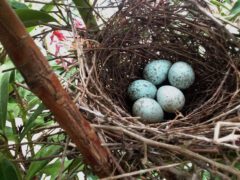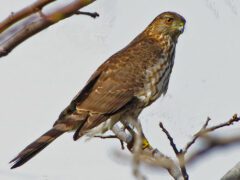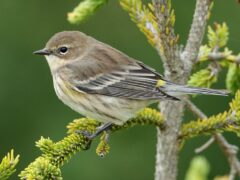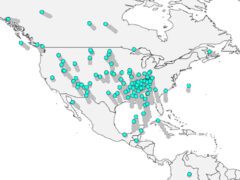Scaly-breasted Munia Similar Species Comparison
Main SpeciesScaly-breasted Munia
Adult and immature (Checkered)
Frequently forages in small groups, perching atop and feeding on grasses and other seeding plants.
© Perry Doggrell / Macaulay LibraryFlorida, November 05, 2016Adult (Checkered)
Builds a large, loose nest of grasses and leaves.
© Ramesh Desai / Macaulay LibraryKarnataka, July 11, 2021Adult (Scaled)
A small songbird with a large, seedeating bill. Adult is brown above, often with fine white streaking, and white below, with dark scaling.
© Ayuwat Jearwattanakanok / Macaulay LibraryChiang Mai, September 27, 2023Adult (Checkered)
The “Checkered” subspecies group, native to South Asia and introduced to parts of the continental U.S., has a chestnut-brown head, distinctive black (not brown) scalloping on the underparts, and orange uppertail coverts.
© Raghavendra Pai / Macaulay LibraryKarnataka, June 28, 2021Adult
A small songbird with a large bill. Adult has brown upperparts, head, and throat, and white underparts with fine dark scalloping.
© José Frade / Macaulay LibrarySetúbal, January 28, 2019Immature
Juvenile has plain brown upperparts and buffy, unmarked underparts. Very similar to juveniles of other munia species and best identified by association with adult Scaly-breasted Munia.
© Sasha Cahill / Macaulay LibraryCalifornia, November 24, 2024Adult (Scaled)
Adults in the “Scaled” subspecies group, found across Southeast Asia, are variable in appearance, but always lack the black scalloping and orange uppertail coverts of the “Checkered” group.
© Natthaphat Chotjuckdikul / Macaulay LibraryNakhon Pathom, October 20, 2019Adult (Checkered)
Uses its heavy bill to eat the seeds of grasses and other plants. Adult in the “Checkered” subspecies group has crisp black scalloping on the underparts and a rich chestnut brown head.
© Sahana M / Macaulay LibraryKarnataka, August 15, 2023Adult (Checkered)
Adult’s scaly breast clearly differentiates this species from other munias, with which it sometimes flocks. This individual’s black underpart markings and orange uppertail coverts identify it as part of the “Checkered” subspecies group.
© Deepak Budhathoki 🦉 / Macaulay LibraryBagmati, September 11, 2023Adult (Checkered)
Introduced to parts of North America, Europe, and Australia, as well as Japan, the Hawaiian Islands, Mauritius, and Reunion. Note pointed tail.
© Neo Morpheus / Macaulay LibraryFlorida, July 12, 2022Adult and immature (Checkered)
A social bird that forages in small groups while breeding and in larger flocks at other times of the year. Immature (in background) is buffy-brown above and slightly paler below. This individual is just starting to show some rich brown on the lower throat.
© Mohan Raj K. / Macaulay LibraryTamil Nadu, November 24, 2022Adult and immature (Checkered)
Frequently forages in small groups, perching atop and feeding on grasses and other seeding plants.
© Perry Doggrell / Macaulay LibraryFlorida, November 05, 2016Adult (Checkered)
Builds a large, loose nest of grasses and leaves.
© Ramesh Desai / Macaulay LibraryKarnataka, July 11, 2021Adult (Scaled)
A small songbird with a large, seedeating bill. Adult is brown above, often with fine white streaking, and white below, with dark scaling.
© Ayuwat Jearwattanakanok / Macaulay LibraryChiang Mai, September 27, 2023Adult (Checkered)
The “Checkered” subspecies group, native to South Asia and introduced to parts of the continental U.S., has a chestnut-brown head, distinctive black (not brown) scalloping on the underparts, and orange uppertail coverts.
© Raghavendra Pai / Macaulay LibraryKarnataka, June 28, 2021Adult
A small songbird with a large bill. Adult has brown upperparts, head, and throat, and white underparts with fine dark scalloping.
© José Frade / Macaulay LibrarySetúbal, January 28, 2019Immature
Juvenile has plain brown upperparts and buffy, unmarked underparts. Very similar to juveniles of other munia species and best identified by association with adult Scaly-breasted Munia.
© Sasha Cahill / Macaulay LibraryCalifornia, November 24, 2024Adult (Scaled)
Adults in the “Scaled” subspecies group, found across Southeast Asia, are variable in appearance, but always lack the black scalloping and orange uppertail coverts of the “Checkered” group.
© Natthaphat Chotjuckdikul / Macaulay LibraryNakhon Pathom, October 20, 2019Adult (Checkered)
Uses its heavy bill to eat the seeds of grasses and other plants. Adult in the “Checkered” subspecies group has crisp black scalloping on the underparts and a rich chestnut brown head.
© Sahana M / Macaulay LibraryKarnataka, August 15, 2023Adult (Checkered)
Adult’s scaly breast clearly differentiates this species from other munias, with which it sometimes flocks. This individual’s black underpart markings and orange uppertail coverts identify it as part of the “Checkered” subspecies group.
© Deepak Budhathoki 🦉 / Macaulay LibraryBagmati, September 11, 2023Adult (Checkered)
Introduced to parts of North America, Europe, and Australia, as well as Japan, the Hawaiian Islands, Mauritius, and Reunion. Note pointed tail.
© Neo Morpheus / Macaulay LibraryFlorida, July 12, 2022Adult and immature (Checkered)
A social bird that forages in small groups while breeding and in larger flocks at other times of the year. Immature (in background) is buffy-brown above and slightly paler below. This individual is just starting to show some rich brown on the lower throat.
© Mohan Raj K. / Macaulay LibraryTamil Nadu, November 24, 2022Adult and immature (Checkered)
Frequently forages in small groups, perching atop and feeding on grasses and other seeding plants.
© Perry Doggrell / Macaulay LibraryFlorida, November 05, 2016Adult (Checkered)
Builds a large, loose nest of grasses and leaves.
© Ramesh Desai / Macaulay LibraryKarnataka, July 11, 2021Similar SpeciesIndigo Bunting
Female/immature
Indigo Bunting overlaps with Scaly-breasted Munia’s introduced range in the Caribbean and along the Gulf of Mexico. Female/immature Indigo Bunting is similarly colored to juvenile Scaly-breasted Munia, but is larger, has a smaller, paler bill, and usually shows at least faint breast streaking and wingbars.
© Lila Theis / Macaulay LibraryTexas, April 27, 2022Similar SpeciesBlue Grosbeak
Female/immature
Blue Grosbeak overlaps with Scaly-breasted Munia's introduced range in Southern California and the Gulf of Mexico coast. Female/immature Blue Grosbeak is similarly colored but significantly larger, with a larger, paler bill; prominent wingbars on dark wings; and a longer tail.
© Ryan Sanderson / Macaulay LibraryIndiana, August 20, 2024Similar SpeciesBlack-throated Munia
Adult
Adult Black-throated Munia has white scaling on dark underparts—the inverse of Scaly-breasted Munia’s underpart pattern.
© Marco Valentini / Macaulay LibraryRatnapura, February 06, 2019Similar SpeciesChestnut Munia
Immature
Juvenile Chestnut Munia and other juvenile munias can be indistinguishable from juvenile Scaly-breasted Munia, which sometimes joins mixed-species flocks.
© Scott Olmstead / Macaulay LibraryHawaii, July 10, 2022Similar SpeciesIndigo Bunting
Female/immature
Indigo Bunting overlaps with Scaly-breasted Munia’s introduced range in the Caribbean and along the Gulf of Mexico. Female/immature Indigo Bunting is similarly colored to juvenile Scaly-breasted Munia, but is larger, has a smaller, paler bill, and usually shows at least faint breast streaking and wingbars.
© Lila Theis / Macaulay LibraryTexas, April 27, 2022Similar SpeciesBlue Grosbeak
Female/immature
Blue Grosbeak overlaps with Scaly-breasted Munia's introduced range in Southern California and the Gulf of Mexico coast. Female/immature Blue Grosbeak is similarly colored but significantly larger, with a larger, paler bill; prominent wingbars on dark wings; and a longer tail.
© Ryan Sanderson / Macaulay LibraryIndiana, August 20, 2024Similar SpeciesBlack-throated Munia
Adult
Adult Black-throated Munia has white scaling on dark underparts—the inverse of Scaly-breasted Munia’s underpart pattern.
© Marco Valentini / Macaulay LibraryRatnapura, February 06, 2019Similar SpeciesChestnut Munia
Immature
Juvenile Chestnut Munia and other juvenile munias can be indistinguishable from juvenile Scaly-breasted Munia, which sometimes joins mixed-species flocks.
© Scott Olmstead / Macaulay LibraryHawaii, July 10, 2022Similar SpeciesIndigo Bunting
Female/immature
Indigo Bunting overlaps with Scaly-breasted Munia’s introduced range in the Caribbean and along the Gulf of Mexico. Female/immature Indigo Bunting is similarly colored to juvenile Scaly-breasted Munia, but is larger, has a smaller, paler bill, and usually shows at least faint breast streaking and wingbars.
© Lila Theis / Macaulay LibraryTexas, April 27, 2022Similar SpeciesBlue Grosbeak
Female/immature
Blue Grosbeak overlaps with Scaly-breasted Munia's introduced range in Southern California and the Gulf of Mexico coast. Female/immature Blue Grosbeak is similarly colored but significantly larger, with a larger, paler bill; prominent wingbars on dark wings; and a longer tail.
© Ryan Sanderson / Macaulay LibraryIndiana, August 20, 2024Compare with Similar Species
Click on an image to compare
Looking for ID Help?
Get a customized list of birds from anywhere in the U.S. or Canada.
View Birds Near Me






